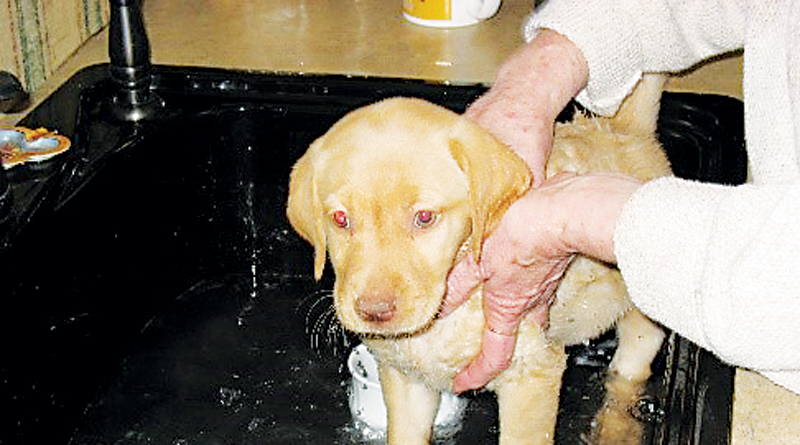THE WORK OF OUR HANDS

Look at your hands. What can you do with them? Maybe you’re adept at carpentry, quilting, playing a musical instrument, drawing, golf, cooking or just bathing a puppy. These skills, and many, many others, all require the work of our hands.
According to Wikipedia, “a hand is a prehensile, multi-fingered appendage located at the end of the forearm or forelimb of primates such as humans, chimpanzees, monkeys, and lemurs.”
The hands of a human being are the chief organs for physically manipulating the environment, using the roughest to the finest motor skills (wielding a club to threading a needle). And since the fingertips contain some of the densest areas of nerve endings on the human body, they also are the richest source of tactile feedback so that the sense of touch is intimately associated with human hands. Although many mammals and other animals have grasping appendages similar in form to a human hand (i.e. paw, claw, talon, etc.), these are scientifically not considered to be so, and have other varying names.
There are hands for healing of a surgeon or minister, hands for helping of a nurse or other caregiver, hands for fixing of a mechanic or repairman, hands for creating of an artist or musician, hands for communicating of a writer or a signer for the hearing impaired, and, unfortunately, hands for hurting of a thief, or of someone wielding a gun, knife or other weapon.
We use our hands to do so many things: tie our shoes, open jars, drive (for now), use our phone, and, of course, to now wash them several times daily, to name just a few. It’s hard to do much of anything without them, but as we get older, our hands can get weaker and less flexible.
The first recorded use of a handshake as a gesture of peace reportedly occurred in Babylonia in 1800 B.C. when the king ritually shook hands with the statue of the god Murduk. This royal sacred gesture eventually became a token of goodwill and an instrument of peace rather than war as people began extending their empty weapon-carrying hand to one another. Similarly, the drink toast we offer by raising our glass (with our hand) to someone and then drinking essentially is a message of goodwill.
When it comes to business dealings, a handshake has long been a sign of respect and goodwill. Handshakes used to be a part of our daily life. But in the wake of the coronavirus we are fast turning into a no-touch society with every possible habit of meeting and greeting taking a back seat. The handshake has morphed into the fist bump (also known as a bro fist, power five, tater, PIB, as in Pound It Bro, knucks or pibbys). Similar in meaning to a handshake or high five, a fist or elbow bump also can be a symbol of giving respect or approval, as well as companionship between two people, or as a form of friendly congratulation. Admittedly, however, these bumps seem awkward outside of a sports arena.
Have you ever heard of Eskimo hands? Artists of the primitive Eskimo Indians had a charming custom of depicting human fingers with holes in their hands. The pierced hands signified any gifts that came to them be allowed to fall through their hands. For the Eskimo culture was one of great hospitality, believing that all life was an interdependent web. Whenever we share our clothing, our food or “belongings” we, too, have Eskimo hands, allowing part of the good things that have come to us to be passed on to others.
When we use our hands to “make” or “perform” compassionate deeds, we mirror the divine, unlike those who refuse to “lift a hand” or “throw up their hands” in anger or despair. Our hands are godlike when they are busy “making love” with acts of affection, such as caretaking, cooking, cleaning, clapping, caressing or carrying another’s burden. “Prosper the work of our hands! Prosper the work of our hands” (Ps 90, 17)!
And there’s a march by John Phillip Sousa titled, “Hands Across the Sea.” Written in 1899, the work is addressed to no particular nation, but to all of America’s friends abroad. Sousa prefaced the musical score with a quotation from the English diplomat John Hookham Frere: “A sudden thought strikes me; let us swear eternal friendship.” The march was composed in the wake of the Spanish-American War and is idealistic, in addition to patriotic, in nature.
The fourth stanza of Samuel Longfellow’s 1886 hymn “Thou, Lord of Our Life, Our Saving Health,” reads: “Bless Thou the gifts our hands have brought; Bless Thou the work our hearts have planned. Ours is the faith, the will, the thought: The rest, O God, is in Thy hand.”
There’s so much more we could say about our “hands” but instead we’ll leave you with an appropriate quote from the late Nelson Mandela: “It is in your hands to create a better world for all who live in it.”
- Who You Calling Santa Claus? - December 5, 2025
- Do’s And Don’ts Of Veteran’s Day - November 7, 2025
- Columbus Sailed The Ocean Blue… But Now What? - October 10, 2025


